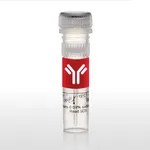Thermo Fisher Scientific Cytokeratin (HMW) Monoclonal Antibody (34bE12)
다른 상품 둘러보기
Applications
Tested Dilution
Publications
Immunohistochemistry (Paraffin) (IHC (P))
2-10 µg/mL
Product Specifications
Species Reactivity
Human
Host/Isotype
Mouse / IgG1
Class
Monoclonal
Type
Antibody
Clone
34bE12
Immunogen
A synthetic peptide of Cytokeratin (HMW)
Conjugate
Unconjugated Unconjugated Unconjugated
Form
Liquid
Concentration
0.5 mg/mL
Purification
Protein A
Storage buffer
PBS with proprietary stabilizer
Contains
0.01% sodium azide
Storage conditions
Store at 4°C short term. For long term storage, store at -20°C, avoiding freeze/thaw cycles.
Shipping conditions
Ambient (domestic); Wet ice (international)
Product Specific Information
Positive control: Skin
Cellular location: Cytoplasmic.
Target Information
Keratins are heteropolymeric structural proteins that form the intermediate filament. Cytokeratins are intermediate filament keratins found in the intracytoplasmic cytoskeleton of epithelial tissue. There are two types of cytokeratins - the low weight, acidic type I and the high weight, basic type II. Cytokeratins are usually found in pairs - one type I and one type II. KRT1 regulates the activity of kinases such as PKC and SRC via binding to integrin beta-1 (ITB1) and the receptor of activated protein C kinase I (RACK1). In complex with C1QBP it is a high affinity receptor for kininogen-1/HMWK. KRT1 is expressed in the spinous and granular layers of the epidermis with family member KRT10. Mutations affecting the gene result in bullous congenital ichthyosiform erythroderma. KRT5 is specifically expressed in the basal layer of the epidermis with family member KRT14. Mutations affecting the gene result in epidermolysis bullosa simplex diseases. KRT10 plays a role in the establishment of the epidermal barrier on plantar skin. It also acts as a mediator of S.aureus adherence to desquamated nasal epithelial cells via clfB - thus it plays a role in nasal colonization. Mutations affecting the gene result in epidermolytic hyperkeratosis. KRT14`s nonhelical tail domain is involved in promoting KRT5-KRT14 filaments to self-organize into large bundles and enhances the mechanical properties involved in resilience of keratin intermediate filaments in vitro. Mutations affecting the gene result in epidermolysis bullosa simplex.
For Research Use Only. Not for use in diagnostic procedures. Not for resale without express authorization.
배송/결제/교환/반품 안내
배송 정보
| 기본 배송비 |
| 교환/반품 배송비 |
|
|---|---|---|---|
| 착불 배송비 |
| ||
| 교환/반품 배송비 |
| ||
결제 및 환불 안내
| 결제수단 |
|
|---|---|
| 취소 |
|
| 반품 |
|
| 환급 |
|
교환 및 반품 접수
| 교환 및 반품 접수 기한 |
|
|---|---|
| 교환 및 반품 접수가 가능한 경우 |
|
| 교환 및 반품 접수가 불가능한 경우 |
|
교환 및 반품 신청
| 교환 절차 |
|
|---|---|
| 반품 절차 |
|

